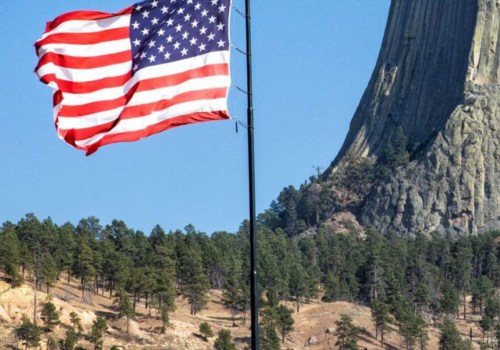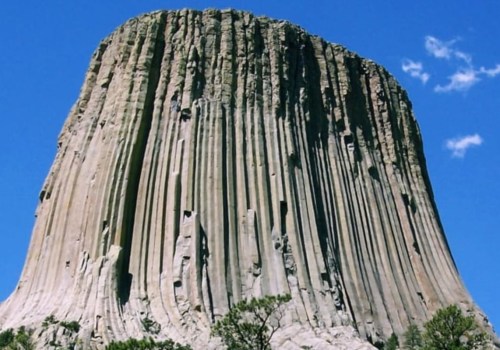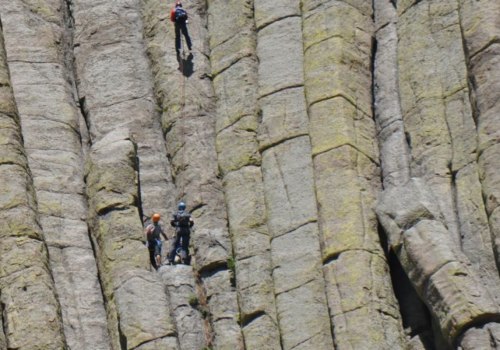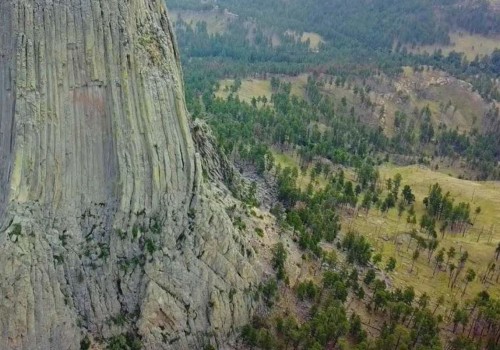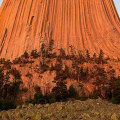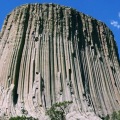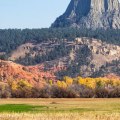Rising above Wyoming's flat landscape is one of the world's natural wonders. Located almost 1,300 feet (395 m) above the Belle Fourche River, thousands of visitors enjoy the Devil's Tower every year and it's a challenge for any adventurous climber. The columns of Devils Tower, which rise hundreds of feet in the air and extend up to 10 feet wide, are truly spectacular. Protected in 1906 for its scientific value, Devils Tower remains a place of scientific study and public wonder.
Devils Tower, an impressive formation in the middle of a relatively flat region, raises natural questions among many spectators about how it was formed. A careful interpretation of the evidence in and around Devils Tower tells us the story. Current research supports the conclusion that the Devil's Tower was not a volcano, but that it was injected between layers of sedimentary rocks and cooled underground. The characteristic furrowed columns are the result of the contraction that occurred during the cooling of the magma.
As volcanic rocks slowly cooled, isolated by sediments, large columns could form. Only subsequent erosion exposed the unusual shape of Devils Tower. Geologists are still puzzled by the details that control the formation and pattern of columns in large bodies of volcanic rock. In nature, joints can form only if the rock is brittle enough and grows over time from cooling from the outside to the still warm and soft inside inside the intrusion.
The column joints develop approximately at right angles to the cooling surfaces, which are generally the tops or bottoms of lava flows, the walls of a magma chamber, or a volcanic conduit. In the case of the Devil's Tower, the columns are tilted toward the base, which also suggests that the cooling surface, the walls of the volcanic plug, were tilted outwards. But why the columns become almost vertical, and therefore a challenge for climbers, in the reconstructed core of the Devil's Tower Intrusion is a bit of a mystery. Geologists assume that the tectonic forces and chemical composition of volcanic rocks influence the distribution of heat within the intrusion. As the joints follow isotherms (lines connecting points of the same temperature), perhaps the modern geometry of Devils Tower reflects the yet understudied mechanisms of magma placement in Earth's upper crust. Devils Tower is an erosive remnant of a volcanic neck, a path of molten rock to the surface. The region has eroded deeply, leaving a highly resistant rock tower that exhibits spectacular columnar junctions, evidence of its origin once melted.
Eventually, receding waters divided into large canals that cut deep valleys and exposed Devils Tower. In 1890, general land office ordered that applications for land ownership around Devil's Tower and Tower itself be rejected. In 1907, scientists Darton and O'Hara decided that Devils Tower should be an eroded remnant of a laccolit. Finally, top of Devils Tower would be drastically smaller than its base as erosion slowly exposed more and more tower. However, columnar junction of Devils Tower is largest and most spectacular example this fascinating geological phenomenon. Geologists Carpenter and Russell studied Devils Tower in late 19th century and concluded that Tower consisted an igneous intrusion (forced entry magma through other layers rock).
Columns Devils Tower almost same height suggesting whole had been single pool magma but fractured into separate columns as cooled. At time Devil's Tower formed surface surrounding land almost 915 m (3,000 feet) higher than today. Since creation took place some 6,000 years ago according Bible Devils Tower could not have formed millions years past. Evolutionary geologists interpret evidence surrounding Devils Tower as evidence millions years slow erosion.
